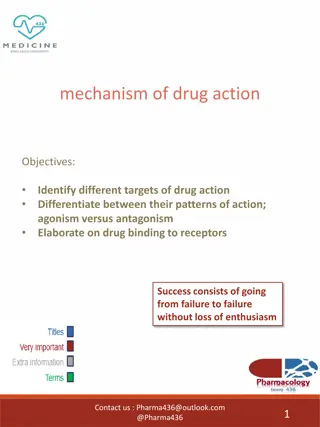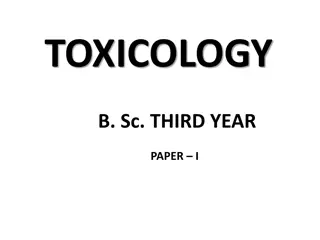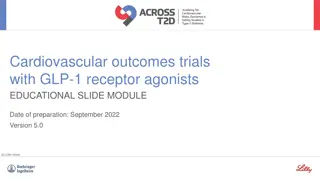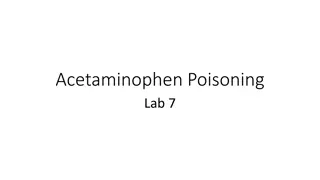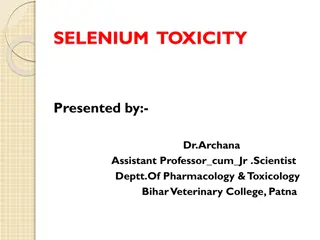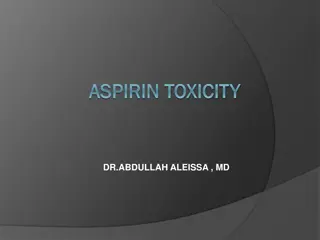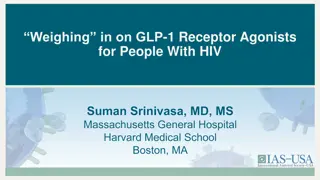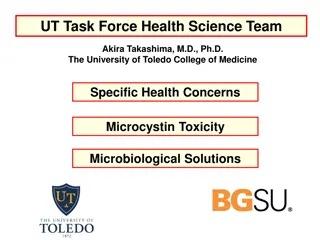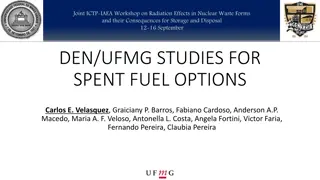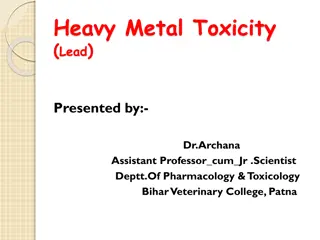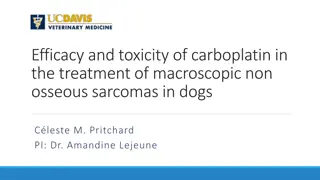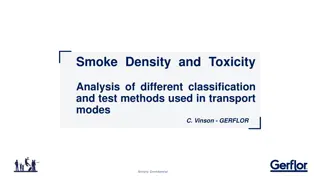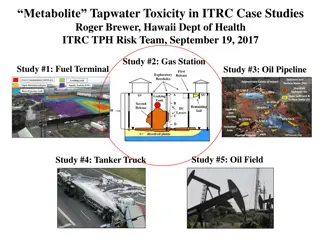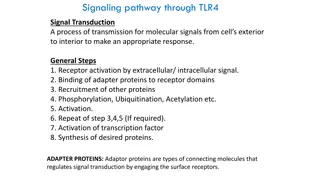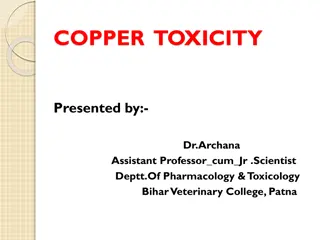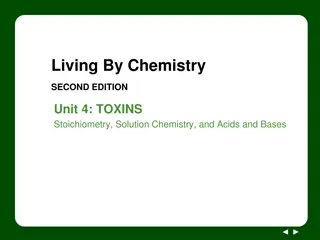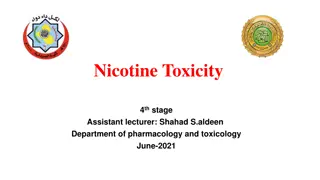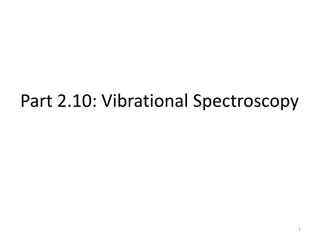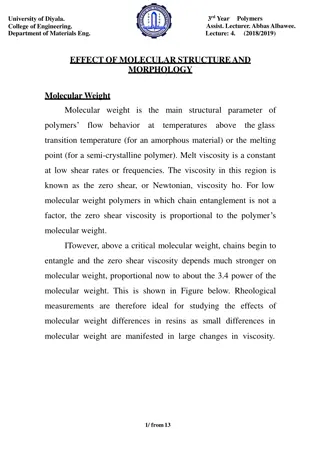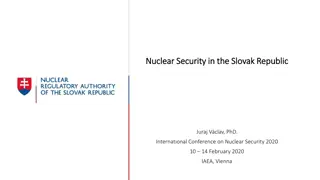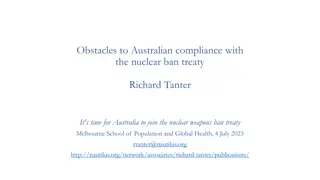Nuclear Receptor-Mediated Toxicity: Molecular Insights and Implications
TOXICOLOGY research on Nuclear Receptor-Mediated Toxicity by Prof. Zdeněk Dvořák delves into the evidence, molecular properties, structures, and signaling pathways of nuclear receptors such as Aryl Hydrocarbon Receptor (AhR). Detailed information on the impact of AhR-mediated toxicity, including ligands, target genes, and toxicological effects, is provided. Understanding the complexities of nuclear receptor interactions sheds light on the mechanisms behind tissue-specific, predictable, and stereospecific toxic effects. These insights contribute to recognizing the role of nuclear receptors in mediating toxic responses to various environmental compounds.
Download Presentation

Please find below an Image/Link to download the presentation.
The content on the website is provided AS IS for your information and personal use only. It may not be sold, licensed, or shared on other websites without obtaining consent from the author. Download presentation by click this link. If you encounter any issues during the download, it is possible that the publisher has removed the file from their server.
E N D
Presentation Transcript
TOXICOLOGY Nuclear Receptor-Mediated Toxicity Prof. RNDr. Zden k DVO K, DrSc., Ph.D. Department of Cell Biology Genetics Faculty of Science, Palacky University Olomouc
Evidence for Nuclear Receptor-Mediated Toxicity: 1. Tissue specific effect 2. Predictable effect 3. Transactivation of specific genes is increased 4. Rapid transcriptional response 5. Reversible binding of compound to intracellular molecules 6. Stereospecific effects Molecular Properties of Nuclear Receptors: 1. Soluble (intra-cellular) receptor that binds a ligand, migrates to cell nucleus and interacts with specific genomic response elements 2. No second messengers in NR signalling 3. Effector is DNA STEROID/THYROID/RETINOID FAMILY PAS (Per/ARNT/Sim) FAMILY Steroid receptors (ER, PR, AR, GR, MR) Vitamin D Receptor (VDR) Retinoid Receptors (RARs, RXRs) Peroxisome proliferator-activated r. (PPARs) AhR = Aryl Hydrocarbon Receptor ARNT = AhR Nuclear Translocator HIF1 = Hypoxia-Inducible Factor
STRUCTURE OF NUCLEAR RECEPTORS dimerization domains D A/B C E F COOH NH2 AF1 N-terminal domain activation function ligand independent AF2 activation function ligand dependent LIGAND BINDING DOMAIN HINGE C-terminal domain variable DNA BINDING DOMAIN
ARYL HYDROCARBON RECEPTOR dioxin receptor ubiquitously expressed (lung, thymus, placenta, liver, kidney, heart, spleen) ligand-(in)dependent activation ligands/activators: NATURAL (flavonoids, isoflavones, stilbenes, anthocyans) DRUGS (omeprazole, lansoprazole, primaquine, ketoconazole) CHEMICALS (SP600125, U0126) ENDOGENOUS (indoles) ENVIRONMENTAL POLLUTANTS (PCBs, PAHs .) target genes CYP1A1, CYP1A2, CYP1B1, phase II enzymes AHRR = AhR repressor forms AHRR/ARNT heterodimer, which binds to XRE but does not trigger gene expression AHRR is up-regulated by AhR = negative regulatory feed-back L DRE XRE AHRE = AhR responsive element = dioxin-responsive element = xenobiotic-responsive element AhR ARNT DRE DRE core sequence consensus sequence 5 -GCGTG-3 5 -T/GNGCGTGA/CG/CA-3
AhR SIGNALLING L L L XAP2 L L hsp90 L L AhR p23 L L hsp90 ARNT L L AhR XAP2 XAP2 L hsp90 AhR ARNT hsp90 L CYP1 CYP1A1 p23 AhR p23 DRE DRE hsp90 hsp90
AHR-MEDIATED TOXICITY AhR binds many polychlorinated aromatic compounds with differing affinity pleiotropic toxicological effects; multitude transcriptional and phenotypic effests PCDDs, PCDFs, PCBs = the most toxic environmental chemicals highly lipophilic persistent compounds = long biological t (7 11 years!) different degree of chlorination = many congeners; variable toxic potential often mixtures relative measure of toxicity = TOXICITY EQUIVALENTS (T.E.) T.E.s calculated for the most potent congener TCDD; T.E. = 1.0 relative toxic potential of PCBs, PCDDs and PCDFs correlates with their affinity to AHR binding to AHR is optimal when ligand is coplanar polychlorinated dibenzodioxins PCDDs (75 congeners) polychlorinated dibenzofurans PCDFs (75 congeners) polychlorinated biphenyls PCBs (209 congeners) 2,3,7,8,-tetrachloro-p-dibenzodioxin TCDD Ganey PE, Boyd SA (2005) An approach to evaluation of the effect of bioremediation on biological activity of environmental contaminants: dechlorination of polychlorinated biphenyls. Environ Health Perspect. 113(2):180-5
AHR-MEDIATED TOXICITY - TCDD environmental pollutant with a very high toxic potential featuring pleiotropic activity immunotoxicity, endocrine toxicity, embryotoxicity, teratogenesis (in aminals) human carcinogen Class 1 via non-genomic mechanisms acute toxicity = maximal effects after 2-4 weeks after single exposure species-specific sensitivity; e.g. guinea pigs (LD50 500 ng/kg) vs hamster (LD50 5 mg/kg) in humans chloracne = persistent disturbance of epithelial cells differentiation in skin high affinity of TCDD to AHR ( Kd = 10-11 M) species-specific(!) TCDD-activated AHR triggers transcriptional response of many genes, but one single toxicity gene dysregulated by AHR is unlikely Evidence for AHR-mediated toxicity of TCDD: Responsiveness to TCDD positively correlates and segregates with Ahb-l allele The Kd for TCDD of nonsensitive mouse strains is 10-20 x higher than of sensitive ones AHR-null mice are resistant against toxic effects of TCDD
AHR-MEDIATED TOXICITY TCDD CANCER mechanism is probably combined, involving disruption of cell cycle and oxidant stress TCDD alters transcription factors (E2F) and cyclin-dependent kinases inhibitors (p27kip1), resulting inCELL CYCLE DISRUPTION TCDD induces extensive OXIDANT STRESS by induction of CYP1A1/2 and in mitochondria by interfering with electron transport chain (oxidation of SH- groups, increase of Ca2+, ROS production, DNA damage) ROS production in mitochondria is low in AHR-knock-out mice = mitochondrial oxidant stress depends rather on AHR than on CYP1A1/2 CYP1A1/2 OXIDATIVE STRESS TCDD mitochondria AHR CANCER P27kip1; E2F CELL CYCLE DISRUPTION TRICLOSAN antifungal, antibacterial tooth pastes, soaps, deodorants gets to environment where it undergoes photochemical degradation to 2,8-DCDD http://p.ananas.chaoxing.com/star3/origin/54c6ee44e4b0f325656f226e.png
ESTROGEN RECEPTOR - ER exists in two forms ER and ER distinct proteins differing in transcriptional activity tissue-specific expression forms homodimers ER /ER and ER /ER ER form preferentially heterodimer ER /Er ER binds large variety of chemically unrelated compounds = promiscuity L L ER ER ERE Estrogen Response Element ERE XENOESTROGENS = environmental estrogens xenobiotics that can elicit agonistic (enhancing) response mediated by ER responsible for hormonally-controlled cancers (mammary, testicular, prostate) interfere with normal reproduction in wildlife DDT, hydroxy-PCBc, alkylphenols, bisphenol A, diethylstilbestrol (anti-abortive) complicated risk assessment A) xenoestrogens are usually weak ER agonists, i.e. they have low relative estrogenic potency as compared to endogenous estrogens = rather high concentrations of xenoestrogens are required to elicit adverse effect B) environmental stability, bioaccumulation, high lipophilicity = increased danger
ER-MEDIATED TOXICITY: ALKYLPHENOLS alkylphenol ethoxylates industrial and household use detergents, emulsifiers massive commercial production nonionic surfactants, stabilizers in plastics bacterial degradation to alkylphenols alkylphenols - very low acute toxicity vs accumulation in organisms and sediments - estrogenic activity !!! the most known p-nonylphenol (PNP) PNP binds to and activates ER transactivation of estrogen-responsive genes Risk of PNP is low or high? PNP has 30.000x lower affinity to ER than E2 PNP is inactivated by glucuronidation PNP does not cross placental barrier PNP accumulates in fat tissue upon sudden weight loss, PNP can be mobilized from adipose tissue and plasma levels can reach 10 x of those before fasting risk assessment must be very complex p-nonylphenol estradiol
ER-MEDIATED TOXICITY: ER AHR cross-talk between nuclear receptors, e.g. ER vs AHR biphasic effects of TCDD on ER: positive and negative Monostory K., Pascussi J.M., Kobori L., Dvorak Z. (2009) Hormonal regulation of CYP1A expression. Drug Metab Rev 41(4):547-572.
ANDROGEN RECEPTOR - AR pivotal role in development of male gonadal tissues implicated in development of tumors (prostate cancer) present in most tissues; abundand in male reproductive organs; low levels in female reproductive organs endogenous ligands testosterone, DHT xenobiotics causing endocrine-disruption through AR = ANTIANDROGENS (e.g. Vinclozolin, DDT) L L AR AR ARE Androgen Response Element ARE p,p -DDT p,p -DDE DDT = massively used pesticide in the past; DDE = breakdown product of DDT DDE = antiandrogen, persistent, lipophilic, widespread in environment DDE blocks AR functions in multiple ways: Some xenobiotics are dual ECD: XENOESTROGENS and ANTIANDROGENS e.g. bisphenol A, p-nonylphenol AR interaction with coactivators androgen binding with AR AR nuclear translocation DNA binding
PEROXISOME PROLIFERATOR-ACTIVATED RECEPTOR - PPAR PPARs endogenous ligands: fatty acids and eicosanoids+metabolites subtypes: PPAR , PPAR (= PPAR ), PPAR different tissue distribution and function name PPAR historic reasons = ligands for PPAR caused proliferation of peroxisomes in rodents ; but in humans it is not true; better fatty acid-activated receptor peroxisomes = subcellular organelles that function as sites of fatty acyl- -oxidation, cholesterol metabolism glycerolipid synthesis and other lipids pathways peroxisome proliferators = chemically diverse compounds (clofibrate, ciprofibrate, gemfibrozil, nafenodipin, plasticizers phtalates, solvents PPs induce proliferation of peroxisomes and cause liver tumors in rodents the common for PPs is that they are ligands for PPARs = chicken egg problem all subtypes of PPAR form heterodimer with RXR L PPAR RXR PPAR-RE
PPAR -MEDIATED TOXICITY PPAR ligands/activators cause hepatocarcinogenesis PPs stimulate replicative DNA synthesis and liver growth = tumor-promoting characteristics PPs inhibit hepatocyte apoptosis in vivo and in vitro tumor-promotion involvement of tumor necrosis factor beta (TNF ) it suppresses apoptosis and stimulates DNA syntesis in hepatocytes role for mitogen-activated protein kinases (MAPKs; p38) activated by oxidative stress PPs increase fatty acyl- -oxidation (in rodents not in man) increased production of H2O2 Reactive Oxygen Species = oxidant stress sustained oxidative stress leads to nongenotoxic liver carcinogenesis demonstrated in rodents not in man = perhaps irrelevant mechanism in man? PPAR activation fatty acid oxidation ROS oxidative stress DNA replication Cell growth Inhibition of apoptosis + DEHP; diethyl hexyl phtalate TNF MAPK initiation (genotoxicity) tumor progression promotion
PPAR -MEDIATED TOXICITY PPAR interestingly participates in cytoprotection against chemically different and mechanistically distinct hepatotoxicants clofibrate (hypolipidemic drug class fibrates ) has hepatoprotective effect against liver injury induced by acetaminophen APAP, carbon tetrachloride, bromobenzene, chloroform mechanism of protection is unrelated to mechanism of liver injury PPAR null mice had lost the ability to be resistant against APAP when given clofibrate; they also showed impaired liver regeneration after partial hepatectomy PPAR controls growth regulatory genes (c-Ha-ras, fos, jun, egr-1) that are involved in the progression of cell cycle (G0 S transition) the mechanism of PPAR -mediated hepatoprotection may involve stimulation of mitogenic response increased hepatocellular proliferation regeneration acetaminophen (paracetamol) clofibrate
PPAR -MEDIATED TOXICITY PPAR opposing receptor = mediates biological functions opposite to those by PPAR antitumor effects, increase the storage of lipids PPAR encoded by single gene, highly conserved structure in mice, rats, humans alternative promotor use and alternative splicing = PPAR PPAR PPAR two forms of proteins identified: PPAR PPAR distinct tissue distribution extra-adipose tissues (PPAR ) vs adipose tissue (PPAR ; 10-100x more) expression of PPAR is influenced epigenetically ( nutrition, obesity, type II diabetes) activation of PPAR drastically differs under normal and pathophysiological conditions! several drugs (e.g. thiazolidinediones, TZD) are ligands for PPAR TZD can induce fat accumulation in the bone marrow anemia TZD cause fatty changes in mice liver enlargement of liver, microvesicular steatosis occured only in obese mice with type II diabetes!! extrapolation to humans?? rosiglitazone troglitazone
PPAR -MEDIATED TOXICITY TZD increased transcription of adipocyte-specific PPAR regulated genes in bone marrow stromal cells OBESE mice have highly up-regulated expression of PPAR in liver TZD induced transcription of genes involved in lipid metabolism (fatty acid-binding protein, fatty acid traslocase) in liver of OBESE but not LEAN mice!! translation to humans?? FUNCTIONAL CHANGES BY TZD-PPAR : Increased flux of non-esterified fatty acids NEFA from adipose tissue to liver in obese animals = continuous exposure of hepatocytes to fatty acids Increased de novo synthesis of fatty acids from glucose in liver (through PPAR ) Up-regulation of fatty acid trasporters and binding proteins (PPAR regulated genes) Inhibition of fatty acids -oxidation by TZD AHR-PPAR cross-talk? TCDD down-regulates PPAR Relation between TCDD exposure and development of type II diabetes in humans
RETINOIC ACID RECEPTOR - RAR physiological ligands for RAR: retinol, all-trans-retinoic acid RAR expressed abundandly in liver, also testes and epididymis (Sertoli cells) perturbation of RAR (agonist/antagonist) testicular toxicity and embryotoxicity BMS189453 retinoid analogue (treatment of skin diseases) induced testicular atrophy and hypospermia in rats symptoms of vitamin A deficiency retinoids are important in embryonic development xenobiotics that interfere with RAR during embryonic development cause developmental abnormalities L RAR RXR RARE PHENYTOIN: Anticonvulsant Causes embryopathy and teratogenic effects in animals and humans (craniofacial abnormalities, microcephaly) Up-regulates RAR in embryonic tissues


